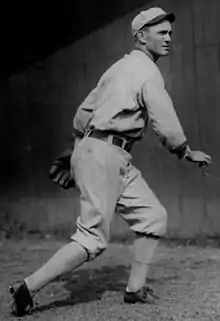Charlie Robertson
Charles Culbertson Robertson (January 31, 1896 – August 23, 1984) was an American professional baseball player. He played in Major League Baseball as a pitcher, and is best remembered for throwing a perfect game in 1922.
| Charlie Robertson | |
|---|---|
 | |
| Pitcher | |
| Born: January 31, 1896 Dexter, Texas | |
| Died: August 23, 1984 (aged 88) Fort Worth, Texas | |
Batted: Left Threw: Right | |
| MLB debut | |
| May 13, 1919, for the Chicago White Sox | |
| Last MLB appearance | |
| June 18, 1928, for the Boston Braves | |
| MLB statistics | |
| Win–loss record | 49-80 |
| Earned run average | 4.44 |
| Strikeouts | 310 |
| Teams | |
| Career highlights and awards | |
| |
Early life and Career
Robertson was born in Dexter, Texas,[1] grew up in Nocona, Texas, and graduated from Nocona High School in 1915. Charles attended Austin College[1] from 1917 until 1919.
He began his career with the Chicago White Sox in 1919 at the age of 23. Robertson was an average player for most of his career, having a career record of 49–80[1] and never winning more than he lost during a single season.
His main pitch throughout his career was a slow curveball which he often threw on the first pitch to a batter on any side of the plate, followed by a fastball up in the zone.
Perfect Game
On April 30, 1922, in just his fourth career start,[1] he pitched the fifth perfect game in baseball history against the Detroit Tigers at Navin Field (later known as Tiger Stadium) in Detroit. He became the first pitcher in major league history to throw a perfect game on the road. The Detroit lineup featured such Hall of Famers as Ty Cobb and Harry Heilmann, who both complained that he was doctoring the ball throughout the game.[1] A spectacular diving catch by Johnny Mostil on a liner to left by Bobby Veach in the second inning preserved the historic feat.[1] The Tigers submitted several game balls to American League President Ban Johnson after the game to check for irregularities,[1] but Johnson dismissed the charge.
No pitcher would equal the feat after Robertson for another 34 years, when Don Larsen did so in the 1956 World Series against the Brooklyn Dodgers; the next regular season perfect game would not come until Jim Bunning's perfect game in 1964.
After the victory, he suffered arm troubles for the rest of his career. He pitched one season for the St. Louis Browns and two years with the Boston Braves and retired from baseball in 1928.
Personal life
After retiring from baseball, Robertson became a prosperous pecan broker in Fort Worth, Texas. He returned to the limelight after Don Larsen threw a perfect game in the 1956 World Series, the first in the Major Leagues since Robertson's own 34 years earlier. Six days after Larsen's game, Robertson appeared as a contestant on What's My Line?.[2]
Robertson was married to Fay Redus whom he met when he was first invited to spring training by the Chicago White Sox.[3] He died in 1984 in Fort Worth, Texas, at age 88, the last surviving member the infamous 1919 Chicago White Sox.
References
- Coffey, Michael (2004). 27 Men Out: Baseball's Perfect Games. Atria Books. pp. 36–51.
- "What's My Line, Episode 332". YouTube. October 14, 1956.
- "Charlie Robertson (SABR BioProject)". Society for American Baseball Research.
External links
- Career statistics and player information from Baseball Reference, or Fangraphs, or Baseball Reference (Minors)
- Charlie Robertson's perfect game - Box Score - Baseball Almanac
- Charlie Robertson - Society for American Baseball Research (SABR BioProject)
- Charlie Robertson - BaseballBiography.com
- Charlie Robertson at Find a Grave